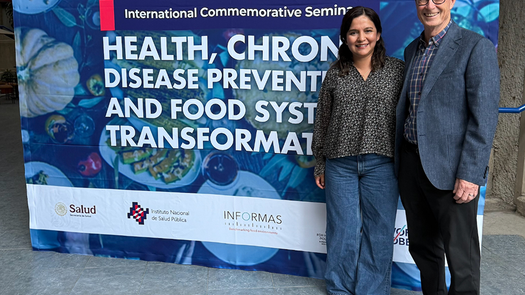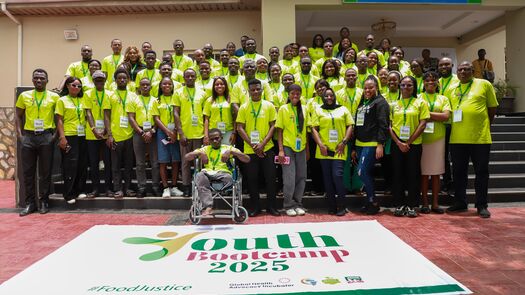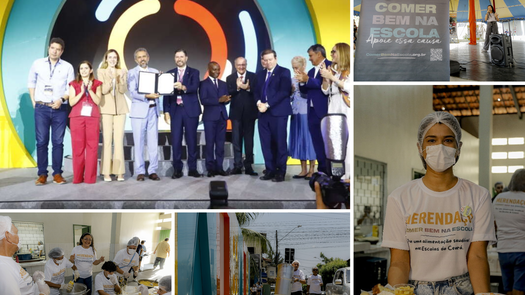November 25, 2025
August 7, 2025
by Mariana de Araujo Ferraz, PhD
Parents Alone Together: What Is at Stake in Building Enabling Breastfeeding Environments

By Mariana de Araujo Ferraz, PhD
It’s early in the morning—perhaps three or four a.m. —I can no longer be sure. It is yet another sleepless night within the vastness of darkness. As a mother, I find myself swimming against the tide, striving to offer the very best I can to my baby through breastfeeding. In these quiet hours, when silence is broken only by the sharp cry for nourishment, there we are—parents in the dark, seemingly alone, yet deeply connected to one another by an extraordinary force that drives us beyond our own limits.
I am a Brazilian lawyer, a public health advocate, and someone who has built her professional career around the right to adequate and healthy food. This path has shown me the importance of breastfeeding—not just as an act of care, but as a right: a right for the breastfeeding parent, and a right for the child to receive the best possible foundation for healthy development. Breastfeeding offers critical health benefits by delivering optimal nutrition, strengthening the infant’s immune system, and reducing the risk of infections, obesity and chronic diseases[1] [2] [3]. It also supports the mother by promoting bonding and lowering the risk of postpartum depression[4], while also reducing the risk of breast and ovarian cancers[5]. I learned this before becoming a mother, still young and at the beginning of my career. I collaborated with advocacy groups dedicated to protecting breastfeeding by working to implement laws regulating the marketing of breast milk substitutes (encompassing commercial milk formula and other products that disrupt breastfeeding). Yet now, having experienced motherhood firsthand, I am better able to grasp the breadth of the challenges surrounding breastfeeding. I see more clearly how far our society still is from providing families with an environment that genuinely protects and promotes this fundamental right.
The environment surrounding infant feeding is shaped by powerful political and economic forces that, in turn, serve commercial interests often at odds with the logic and practice of breastfeeding. The World Health Organization recommends exclusive breastfeeding for the first six months of life, followed by continued breastfeeding alongside complementary foods for up to two years or beyond[6]. Nevertheless, adherence to these recommendations remains limited, with global breastfeeding rates falling short of established public health goals. Responsibility for this situation cannot be placed on the individual. That is, in contexts where we are led to believe that “it’s all the mother’s fault”, there are, in fact, broader factors that hinder or discourage breastfeeding.
With the birth of a baby, there is also the birth of a mother, a father, or the caregivers responsible for this new life. In a capitalist society, however, it’s also the birth of new potential consumers who can be targeted by aggressive marketing campaigns promoting commercial milk formula and products that may disrupt breastfeeding or contribute to early weaning. These include items like baby bottles, nipples, pacifiers, infant formula, follow-on formula, and growing-up milks. The International Code of Marketing of Breast-milk Substitutes, adopted by the World Health Assembly in 1981, sets forth guidelines to protect breastfeeding by regulating the promotion of commercial milk formulas and related products. It prohibits direct advertising to the public, bans the distribution of free samples and promotional gifts to healthcare providers and parents, and requires labels to clearly communicate the benefits of breastfeeding while avoiding any imagery or language that idealizes formula feeding[7]. While infant formula can play a vital role in specific medical situations where breastfeeding is not possible, its use should be guided by clinical need rather than commercial influence, in line with public health recommendations. The implementation of the Code varies across the globe. Countries like Brazil, India, and Sri Lanka have incorporated the Code into national law—banning public advertising, free samples and enforcing strict labeling rules. These measures have contributed to higher breastfeeding prevalence rates in these countries. Countries like the United States have not adopted the Code.
Today, marketing strategies have grown increasingly sophisticated, especially through digital platforms that employ data collection, consumer profiling and artificial intelligence to target parents and caregivers. Influencer endorsements and branded virtual support groups have become widespread, raising serious concerns about the subtle and often misleading promotion of products that disrupt breastfeeding. In response, the World Health Assembly adopted a resolution in 2025 aimed at strengthening the regulation of digital marketing practices related to these products.
Another critical factor that runs counter to breastfeeding recommendations is limited parental leave policies. The absence of protective laws forces many parents to return to work prematurely—a factor strongly associated with early weaning and reduced breastfeeding duration[8]. This return places immense pressure on the breastfeeding parent, who is expected to perform in the workplace while coping with the physical and emotional toll of the postpartum period. Moreover, parental leave for the non-breastfeeding parent is rarely designed as a structural support for breastfeeding, perpetuating a gender imbalance in caregiving. Research shows that paid parental leave is associated with improved maternal mental health, higher child vaccination rates, reduced infant mortality and enhanced cognitive development. It also contributes to increased labor force participation among women, reduced turnover costs for employers and long-term productivity gains.[10] [11] Yet, progress in this area remains limited, underscoring the lack of recognition of the issue but also a failure to prioritize public health and social equity over short-term commercial interests.
Creating supportive environments for breastfeeding requires robust regulatory frameworks that extend beyond the home. In the workplace, policies mandating access to clean, private lactation rooms equipped with potable water, refrigeration for stored breast-milk, and reasonable break time are essential for enabling breastfeeding continuation after maternity leave. Such standards are recommended by the International Labor Organization, yet public spaces—such as airports, shopping centers, parks, schools, and hospitals—often lack similar accommodations. Many mothers across the globe are still forced to express milk in unsanitary public restrooms or face judgmental stares and restrictive attitudes from society at large. Expanding breastfeeding-friendly infrastructure, alongside anti-discrimination protections for public breastfeeding, is critical to normalizing the practice and supporting maternal and child health across diverse settings.
My baby just turned two, and as we enter the month of August—National Breastfeeding Month, with its first week (August 1–7) dedicated to World Breastfeeding Week—I feel proud to have breastfed him to this age and to have followed the WHO’s recommendations to the letter. Yet I know I am just a drop in the ocean—privileged to have had supportive factors that made breastfeeding possible. Still, I carry deep empathy for the many caregivers who wished to meet this goal but were held back by an unsupportive and unregulated environment. Back in the quiet darkness of the night, I reflect on this parallel universe that silently and invisibly connects parents pushing past their limits to give their children the very best. It’s inspired me to put these words to paper and to shed light on the environmental, political, and economic forces that shape the breastfeeding experience. The promotion and protection of breastfeeding cannot rely solely on individual willpower or voluntary industry pledges. It requires mandatory regulations, clearly enforced, that include the control of predatory marketing, regulation of ultra-processed foods, and the guarantee of structural supports such as paid and extended parental leave and breastfeeding-friendly public and workplace environments. It must be guided by robust, free of conflict-of-interest research that clarifies the long-term social and economic returns of such interventions. It takes a village to raise a child— something that calls for a renewed societal pact and collective action involving policymakers, public health institutions, the labor sector, and philanthropic support for research and advocacy in this field. This is the only way forward if we truly want to build a society that protects health and upholds children’s rights.
________
[1] World Health Organization. (2022). Infant and young child feeding. https://www.who.int/news-room/fact-sheets/detail/infant-and-young-child-feeding
[2] Horta, B. L., & Victora, C. G. (2013). Long-term effects of breastfeeding: a systematic review. WHO. https://apps.who.int/iris/handle/10665/79198
[3] Victora, C. G., et al. (2016). The Lancet, 387(10017), 475–490. https://doi.org/10.1016/S0140-6736(15)01024-7
[4] Kendall-Tackett, K. (2007). A new paradigm for depression in new mothers. International Breastfeeding Journal, 2(1), 6. https://doi.org/10.1186/1746-4358-2-6
[5] Collaborative Group on Hormonal Factors in Breast Cancer. (2002). Breast cancer and breastfeeding: collaborative reanalysis of individual data from 47 epidemiological studies. The Lancet, 360(9328), 187–195. https://doi.org/10.1016/S0140-6736(02)09454-0
[6] World Health Organization. (2023). Infant and young child feeding. https://www.who.int/news-room/fact-sheets/detail/infant-and-young-child-feeding
[7] World Health Organization. (2023). Breastfeeding and the International Code of Marketing of Breast-milk Substitutes. https://www.who.int/news-room/fact-sheets/detail/breastfeeding-and-the-international-code-of-marketing-of-breast-milk-substitutes
[8] Ogbuanu, C., Glover, S., Probst, J., Liu, J., & Hussey, J. (2011). The effect of maternity leave length and time of return to work on breastfeeding. Pediatrics, 127(6), e1414–e1427. https://doi.org/10.1542/peds.2010-0459
[9] Insana, S. P., Montgomery-Downs, H. E., & O’Brien, L. M. (2013). Sleep and postpartum depression: What do we know? Sleep Medicine Clinics, 8(3), 309–317. https://doi.org/10.1016/j.jsmc.2013.04.005
[10] Ruhm, C. J. (2000). Parental leave and child health. Journal of Health Economics, 19(6), 931–960. https://doi.org/10.1016/S0167-6296(00)00047-3
[11] Heymann, J., Raub, A., & Earle, A. (2011). Creating and Using New Data Sources to Analyze the Relationship Between Social Policy and Global Health: The Case of Maternal Leave. Public Health Reports, 126(Suppl 3), 127–134. https://doi.org/10.1177/00333549111260S316



